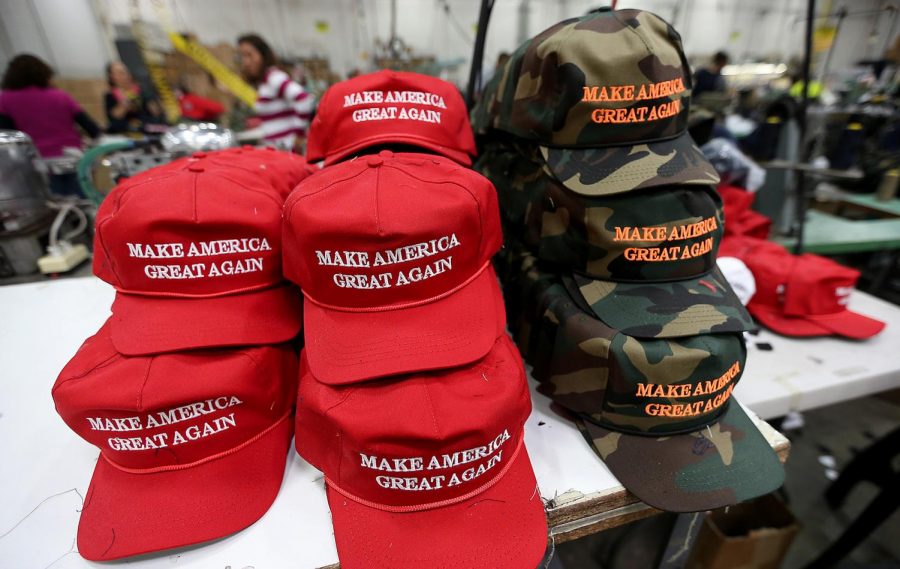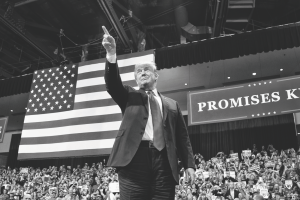Column: MAGA is becoming a symbol of white supremacy
The ‘Make America Great Again’ slogan has shown its face in various ugly incidents of racism and become a symbol of white supremacy in Trump’s America.
Workers stitch together hats on the factory floor of Cali Fame and Cali Headwear in Carson, Calif. The hat and apparel maker is best known for producing Donald Trump’s Make America Great Again baseball caps. (Luis Sinco/Los Angeles Times/TNS)
January 27, 2019
The viral video showing a standoff between a Covington Catholic High School student and a Native American veteran shed light on the escalating visibility of racial issues and cultural insensitivities in President Trump’s America, ranging from the meaning of “Make America Great Again” hats to media coverage.
On Jan. 18, an initial video documenting the incident was released which portrayed the student, Nick Sandmann, in what appeared to be a display of white supremacy in his smirking ignorance toward Native American Nathan Phillips. Sandmann appeared to refuse to move from the spot in front of Phillips and maintained a sniggering character toward the traditional Native American song Phillips was playing on his drum.
The tune Phillips sang was from the American Indian Movement from the 1970s. AIM was a political movement that strove to create economic independence for Native people and strove to abolish police brutality, racism, and imperialism affecting Native peoples. That fact that this song was being mocked adds insult to injury in the controversy. Not only were the students mocking traditional Native dances and songs, but they were also mocking a resistance song that was written during a time of great political unrest. This song was meant to uplift Native people around the country and to have it mocked so publicly is hurtful — a fact that was overlooked by many media outlets.
A longer video was later released, showing Sandmann and his peers appearing to mock traditional dances of Native Americans, prompting Phillips to walk over to Sandmann. It’s this video that has caused public, white outrage, arguing Phillips approached Sandmann. Trump backed up this outrage with a tweet, showcasing once again that culture wars are becoming more intense with public divide and a president who often sides with a white-favoring audience.
Looking like Nick Sandman & Covington Catholic students were treated unfairly with early judgements proving out to be false – smeared by media. Not good, but making big comeback! “New footage shows that media was wrong about teen’s encounter with Native American” @TuckerCarlson
— Donald J. Trump (@realDonaldTrump) January 22, 2019
In reality, the longer video didn’t change much of the scenario, except for the fact that we see the Black Israelites as the true center of where many of the issues at Lincoln Memorial Park stemmed from. Sandmann and his peers were still blocking Phillips in a disrespectful manner with an ignorant air. Sandmann claims he stood still in an effort to “diffuse the situation,” while Phillips said the encounter made him feel “blocked and intimidated.” The smirk on Sandmann’s face is what drove many to believe the encounter was deliberate and out of malice, rather than out of an attempt to diffuse the situation, as Sandmann claims. Although the original video should have been posted in full, it doesn’t change the significance derived from it.
RELATED: Infiltrating the KKK: Ron Stallworth’s story
On both sides, there were points of misinformation. For example, many news outlets claimed Phillips was a Vietnam veteran when in fact he was serving as an infantryman and refrigerator technician during “Vietnam-times” but was never a combat veteran. Another example of misinformation is the controversy surrounding an alleged tweet from Sandmann’s mother, Julie Sandmann, in which she allegedly wished the “pioneers had brought more blankets with smallpox.” Whether or not this tweet was accurately attributed to her is currently in question. However, it still sparked widespread controversy online. Interestingly, neither person has tried to deny either of these rumors. Phillips, in fact, claimed in a Facebook Live video that he served as a combat veteran. When news outlets labeled him as such, he didn’t dispel these rumors. Conversely, when the controversy arose from Julie Sandmann’s alleged tweet, she didn’t comment on the issue.
RELATED: Workshop confronts white supremacy at UI
The incident overall displays that the “Make America Great Again” phrase has become a symbol of white supremacy. This is clear when we see images of private-school white boys chanting “Build that wall!” to Native Americans who were here before them. It isn’t a coincidence that students supporting a slogan that has its roots in blatant racism would cause such a stir at an Indigenous People’s March. It’s clear that “MAGA” is symbolic of white supremacy when it is consistently and directly associated with acts of blatant racism and has been supported by those who actively try to further tear down marginalized groups.
The slogan has showed itself in countless instances in which minority groups are blatantly mistreated. This ugliness is enabled by the very president of the United States — for example, when he excused the grotesque attacks on African Americans in the aftermath of the Charlottesville rally and car attack.
RELATED: Neal: Respecting Republicans while resisting Trump
“You had some very bad people in that group, but you also had people that were very fine people, on both sides,” Trump said in a press conference relating to the incident.
This issue of white supremacy is not only a problem because of the actions it inspires, but also the fact that its instigators often are the only voices with the accessibility to tell stories. Their voices shape our news and frame what stories are told. Nick Sandmann told his side of the story on a video interview with The Today Show, where he was able to defend his actions. However, Phillips was not given the same opportunity, and thus his voice wasn’t able to be heard in the same capacity. While many condemned Nick Sandmann online, general media coverage has done little to condemn his actions. The media focuses on Phillips having had a criminal record while Nick Sandmann gets the limelight for hiring an attorney because of the media skewing the story in Phillips’ favor. Stories, and the ways in which they’re told, continue be influenced by a world of white power.
The perpetuation of white supremacy in media storytelling to the general public reinforces the complicit ways in which whiteness is seen as superior, and people of color or culturally different backgrounds are seen as problematic and guilty “others.” The white supremacy “MAGA” represents shows the nature of white fragility, in which any challenge to whites as the center of innocent humanity triggers a range of defensive moves, including the erasure of “colored” stories and the explanation of white ones.






